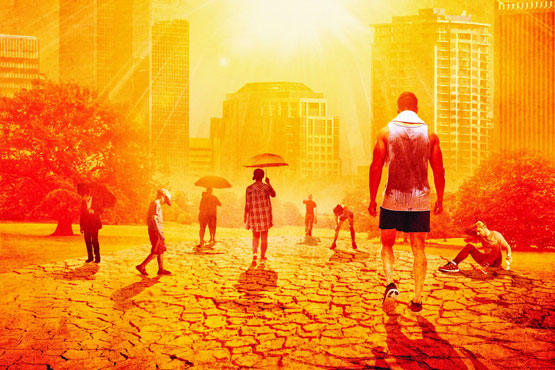Nearly 20m people at risk of extreme heat
Staff Correspondent: More than 17 million people in five major cities of the country are at risk of extreme heat, experiencing various physical problems even during the monsoon. Among them, those under 9 years of age and over 65 are particularly affected by the physical impacts of the heat.
These cities include the capital Dhaka, Chattogram, Khulna, Rajshahi, and Sylhet. Climate and environmental researchers emphasise that in addition to global warming and climate change, the rapid construction of various physical infrastructure and the growing urban population are contributing to the increasing frequency of heatwaves. With an overall decrease in rainfall and rising temperatures, the threat of extreme heat is becoming a recurring issue.
A collaborative study conducted by Australia’s Curtin University and Chittagong University of Science and Technology has shed light on the rising incidence of heatwaves or extreme heat.
In this regard, Ashraf Dewan, the head of the study and a faculty member at Curtin University in Australia, shared with, “A decade ago, we did not witness such heatwaves in our cities. The escalating heat intensity (See Page-7)
(From Page-8)
is primarily attributed to unplanned urbanisation.
“Significant portions of cities are transforming into Heat Islands, leading to increased electricity consumption and various health issues. As cities become economic centers, there’s a surge in migration. We won’t escape this situation unless cities are organised in a planned manner.”
The study identified two main factors contributing to the rise in heatwaves in the country’s major cities: rapid urbanisation and construction of physical infrastructure, and geographical location coupled with climatic changes. Surprisingly, Dhaka city, due to its geographical and weather conditions, was expected to be the least prone to heatwaves.
On the other hand, Rajshahi and Sylhet were anticipated to be the hottest cities. However, the reality is quite the opposite. Approximately 78 per cent or 12.5 million people in Dhaka are now at risk of heatwaves, whereas in Rajshahi, the rate is only 45 per cent, equivalent to around 400,000 people.
The research has also shed light on why the risk of heatwaves is increasing in various cities. Dhaka’s unplanned urbanisation, deforestation, insufficient vegetation along roads, and the destruction of wetlands are identified as key factors contributing to the heatwave. Conversely, Rajshahi experiences the least exposure to heatwaves due to well-planned urbanisation, extensive tree planting, and adequate ventilation.
Sylhet, on the other hand, grapples with an overheated area of 83 per cent due to its geographical location, putting around 500,000 people at risk of heatwaves. In Chattogram, this number stands at 2.9 million, encompassing about 73 per cent of the city’s total population. In Khulna, approximately 700,000 people are at risk, constituting 69 per cent of the city’s population.
One of the key members of the research, Sarfaraz Gani Adnan, told , “Our study did not observe that heat waves increase in any particular area and people’s suffering exacerbate because of climate reasons only. Natural and socio-economic and government planning also play a role in this. Therefore, if we intend to reduce the effect of heatwave in any area, we have to take all those things into account.”
According to the study, the ability to adapt to this heatwave is more influenced by socio-economic factors than natural conditions. For instance, residents of Chattogram exhibit the highest adaptability to heatwaves, with 85 per cent of the total population possessing this trait. In Dhaka, the figure is 79.3 per cent, in Khulna, it’s 79 per cent, in Rajshahi, it’s 87 per cent, and in Sylhet, it’s 48 per cent.
The study also pinpointed the hottest parts of major cities. In Dhaka, Chattogram, and Rajshahi cities, the areas around the main roads experience the highest temperatures. The central parts of these cities also record intense heat. However, the northeast part of Dhaka exhibits relatively lower heat levels due to the presence of most of the wetlands in that area.
In this regard, BRAC University Emeritus Professor Ainun Nishat told, “We often discuss the perils of climate change, but unplanned urbanisation is transforming our cities into heat islands. Consequently, we must revise the development plans and vision for our cities. Our cities clearly demonstrate that development should not solely focus on infrastructure expansion, as it can lead to disasters such as heatwaves. There are valuable lessons to be learned from this.”
Rare Israeli airstrike in Beirut kills Hezbollah commander and more than a dozen others
International Desk: Israel launched a rare airstrike that killed a senior Hezbollah milita…








